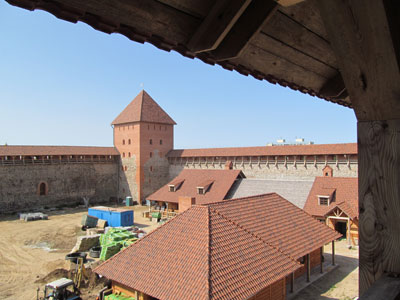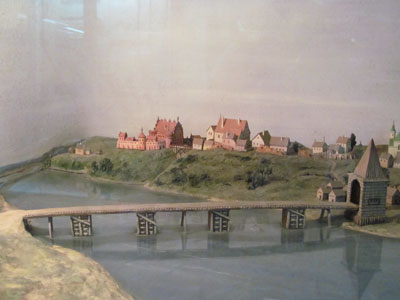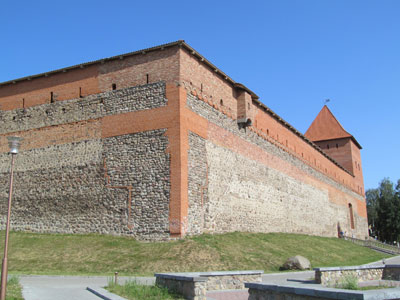Belarus’ Lithuanian heritage
This item appears on page 59 of the January 2014 issue.
(First of two parts)
On each of our trips to Vilnius, my husband, Paul, and I make it a point to leave Old Town, where we always base ourselves and where we spend most of our time, to stroll along Gediminas Prospect in New Town. It’s a one-mile walk along a route lined with cafés and shops, made longer by our many stops to eat and shop.
Our goal, however, is Lithuania’s Parliament at the end of Gediminas Prospect. For us, it’s a “pilgrimage” to honor those who died who were either crushed beneath Soviet tanks or shot in January 1991 after Lithuania declared its independence from the USSR on March 11, 1990.
On one side of the modern Parliament building are the remnants of the 1991 barricades, now enclosed in glass to protect them. But on the opposite side we noticed something new during our latest trip, in June-July 2013. A time line of Lithuania’s history has been erected, graphically displaying the extent of Lithuania’s territory at various points in its thousand years of documented history.
What most riveted our attention was the display labeled “1392 to 1430.” It showed Lithuania, then called the Grand Duchy of Lithuania, sprawled across much of Eastern Europe and encompassing present-day Lithuania as well as parts of Poland, Russia, Ukraine, Moldova, Latvia and all of Belarus. The GDL was the largest state in Europe at the time.
The fact that the GDL included Belarus interested us most of all, since we had planned a 3-day excursion to Belarus as part of our Lithuania trip this time. We decided then that we would search for Lithuania’s medieval and Renaissance past while in Belarus. This meant we would be visiting castles that had associations with either the Lithuanian grand dukes or Lithuanian nobility or both.
Grodno castles
It’s a drive of 105 miles from Vilnius to Grodno in western Belarus. Roads are good, but delays at the Lithuanian/Belarusian border can stretch into hours. We were not lucky; our Belarusian driver told us that the Lithuanians were “miffed” at the Belarusians — or vice versa — so the border crossing took almost three hours.
Grodno, which the Lithuanians call Gardinas, is located on the Neman River just 18 miles from the Lithuanian border. Grodno began as a fortified trading center possibly as early as the late 10th century. By the middle of the 13th century it had come under the control of the Lithuanians, notably Mindaugas (c. 1200-1263), Lithuania’s only crowned king.
Vytautas, grand duke at the time of Lithuania’s greatest territorial extent in the early 15th century, stayed there while preparing for the Battle of Grünwald/Žalgiris (1410), the battle that successfully and decisively eliminated the future threat of Teutonic Knights’ attacks on Lithuanian territories.
Stephen Báthory, Grand Duke of Lithuania as well as King of Poland (and Prince of Transylvania, to boot), made Grodno his royal residence in the late 16th century, and a later grand duke/king, Stanislovas II Augustas, abdicated there in 1795 when Russia swallowed up Lithuania.
What’s left at Grodno now are two castles high above the river and separated from each other by an arched stone bridge.
The one called Old Grodno Castle was built by Grand Duke Vytautas around 1390-1400. This castle was rebuilt in Renaissance style by Stephen Báthory almost 200 years later. The castle’s five Gothic towers are gone, but a good stretch of stone castle walls, the now-dry moat and a 2-story Prince’s Palace are still left.
The Old Castle suffered greatly during the Russo-Polish War of 1654-1667 and the Great Northern War with Sweden in 1700-1721.
After a major fire in 1735, a New Grodno Castle was built just steps away from the Old Castle, joined to it by the stone bridge. This new castle was home to two rulers, Augustas III, who made it his summer residence, and Stanislovas II Augustas, who abdicated there.
Little is left of the original 18th-century palace because of the devastation of World War II, but it’s been reconstructed as a grand neoclassical structure.
Both castles house museums. The Old Castle houses small archaeological and folk art collections and very large natural history and history museums. The New Castle has period-furnished rooms and art exhibits. We were told by a castle administrator that there are plans to restore the Old Grodno Castle to look the way it did in the Renaissance reign of Stephen Báthory.
Lida Castle
Next was Lida Castle, 71 miles northeast of Grodno. Lida was one of several castles built in the early 14th century by Grand Duke Gediminas, credited also with being the founder of the city of Vilnius.
He built the castles as a defense against the Teutonic Knights, who continuously warred against the Lithuanians in a “crusade” to convert the still-pagan Lithuanians to Christianity and to acquire territory for themselves.
An interesting aside — in the 15th century, Grand Duke Vytautas gave Lida Castle to Khan Tokhtamysh, his military ally, who was a descendant of Genghis Khan’s eldest grandson. Tokhtamysh had revolted against Timur (or Tamerlane), one of the greatest of the Mongolian conquerors, and needed a safe refuge.
From the outside, the brick-faced castle is imposing and seemingly impregnable, with two tall towers at its northwest and southeast corners. Still, the Teutonic Knights managed to capture it several times during the 14th century, the Crimean Tatars did so in 1506, the Russians in 1659 during the Russo-Polish War and the Swedes in the early 18th century during the Great Northern War, when they blew up the castle’s towers.
Inside the large courtyard, approximately 264 feet on each side, there once stood an entire settlement with barracks, stables and wells. It’s now being restored and will soon include a restaurant and gift shops in the reconstructed buildings. In the meantime, visitors can walk along the wooden walkways high along the castle’s inner wall and climb inside one of its towers.
Novogrudok Castle
It’s only a 27-mile drive southeast of Lida to Novogrudok, which the Lithuanians call Naugardukas. From what’s left of this castle, it’s hard to imagine its importance.
On one of the highest hills in Belarus (1,066 feet), high above the city of Novogrudok stand two ruined towers, all that remains of what was one of the most important strongholds of the Grand Duchy of Lithuania and once the center of its growing empire.
Lithuanian King Mindaugas may have been crowned there in 1253 and was supposedly buried either there or nearby in 1263.
Repeatedly attacked by the Teutonic Knights in the 14th century (1314, 1321, 1341, 1390 and 1394), the castle had four stone towers added by Grand Duke Vytautas. Three more were added a century later to strengthen the castle’s defenses, but this didn’t stop the sieges of Crimean Tatars (1505), Russians (1654-1657) and Swedes (1706), not to mention the devastations of 20th-century wars and occupations.
The two towers are the sole survivors of 750 years of turbulent history.
If you go…
Our base in Vilnius for 16 nights was the superb Stikliai Palace Residence, adjacent to the Stikliai Hotel (Gaono str. 7, 01131 Vilnius, Lithuania; phone +370 5 264 9595).
We rented an apartment with a living/dining room, fully equipped kitchen, two bedrooms and 2½ bathrooms, all overlooking either the flower-laden courtyard or the church steeples of Old Town.
Rates for one- and two-bedroom apartments with all facilities range from €882 to €1,295 (near $1,200-$1,760) per week, with a one-week minimum.
The adjacent Stikliai Hotel, in which we have stayed in the past, has two restaurants: a haute cuisine French restaurant and a tavern serving authentic Lithuanian food.
I can’t praise the Stikliai Palace Residence enough for its unbeatable location, classiness and level of comfort and service. For us, it is home on our trips to Lithuania.



